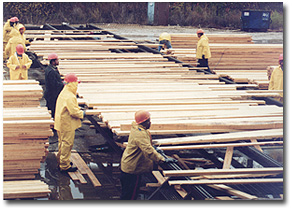Nearly all of the forestland in Maryland is capable of growing trees suitable for wood products. Only about 10% of the forestland is held in reserves where trees are not removed for use. These lands include parts of State forests, designated wildlands, and urban forests. Harvesting and land use change can and has occurred across the remaining 90% of the land, but annual wood growth is more than annual wood removal and has been since 1952. In fact, Maryland’s forests now contain more large trees with increased volume than they did at the turn of the century.
Since 1986, average annual harvesting and land use removal of growing stock volume totals 82.6 million cubic feet. Growing stock volume is a measure of live trees that are considered commercial and measure 5 inches dbh or larger. Sixty-three percent of this removal comes from harvesting, 28% is attributed to volume on timberland reclassified to noncommercial forestland, and 9% comes from timberland converted to nonforest uses. Average annual net growth since 1986 has been 106.8 million cubic feet. This surplus of growth represents an annual net increase in the volume of wood on timberland and an average net gain of 24.1 million cubic feet per year.
Average Annual Net Change of Growing Stock Volume on Timberland, 1986-1999
(in thousands of cubic feet) |
|
Gross
Growth |
Mortality |
Cull |
Net
Growth |
Harvest
Removals |
Land Use
Removals |
Total Removals |
Net
Change |
Softwoods |
29,987 |
-6,254 |
-57 |
23,675 |
-15,981 |
-2,982 |
-18,963 |
4,711 |
Hardwoods |
111,783 |
-30,288 |
1,622 |
83,117 |
-36,072 |
-27,619 |
-63,691 |
19,425 |
Total |
141,769 |
-36,543 |
1,565 |
106,791 |
-52,053 |
-30,602 |
-82,655 |
24,137 |
The economic and population shifts of the early 1900’s affected much of Maryland’s forest today. These forests are being used for a variety of products: building lumber, shipping crates, shelving and furniture, pallets, flooring, molding, mulch, chips for fuel and particle board, and pulp for paper. Many forest stands are now between 70 and 120 years old and have reached the age where most are about 18 inches in diameter. These large trees are used for veneer and other high quality wood products and have brought about an increase in the value of wood products over the last three decades.
 In 1996 (the year for which the most comprehensive information is available), several hundred forest products operators and timber-dependent businesses operated in Maryland. These businesses provided nearly 14,000 jobs, had an annual output value of $2.2 billion, and contributed $.75 billion in value-added economic activity.
In 1996 (the year for which the most comprehensive information is available), several hundred forest products operators and timber-dependent businesses operated in Maryland. These businesses provided nearly 14,000 jobs, had an annual output value of $2.2 billion, and contributed $.75 billion in value-added economic activity.
All regions of Maryland support some level of wood processing but the central and western portions account for over two-thirds of the annual output value and 60% of the employment. This is largely due to a concentration of secondary manufacturers in the central counties and paper and other product mills in the western counties. The eastern counties support the largest timber management and harvesting output ($139 million) and the southern counties follow the central region in secondary wood manufacturing output.
A healthy forest products industry helps ensure a healthy and resilient Chesapeake Bay. Without healthy wood fiber markets, forest landowners would have more economic incentive to grow houses rather than trees! Since forests, as a land cover, are the best for producing clean, fresh water, any loss of forestland to other uses has a detrimental effect on Chesapeake Bay restoration efforts.
The Forest Industry’s Impact
Because of the widespread commercial use of forest resources, timber plays a significant role in the economy of Maryland and the forestry industry has significant links to other Maryland industries. For every dollar of economic output value of the wood products industry, another dollar is produced elsewhere in Maryland’s economy. For every job in the wood products industry, two jobs are stimulated elsewhere. And for every dollar of value produced by the industry, nearly two more dollars in value are added as the product moves up the value-adding chain.*
Another way to look at the impact of the industry is to project how changes in overall output would ripple throughout the state’s economy. A 10% drop in primary wood manufacturing ($72 million) would result in a $156 million drop in the value of all goods and services in the state. Western Maryland would absorb nearly $92 million of this loss. The same 10% decline would cost 1,390 jobs, most of them in Western Maryland. A 10% drop would also have a significant effect on wages, income, and taxes causing a $76 million loss**
* The Economic Importance of the Maryland Forest Products Industry, 1996 of Maryland)
** The Economic Importance of the Maryland Forest Products Industry, 1996
Maryland's Master Logger
Forest Product Operators
Regulations
Reports & Information
Wood Energy